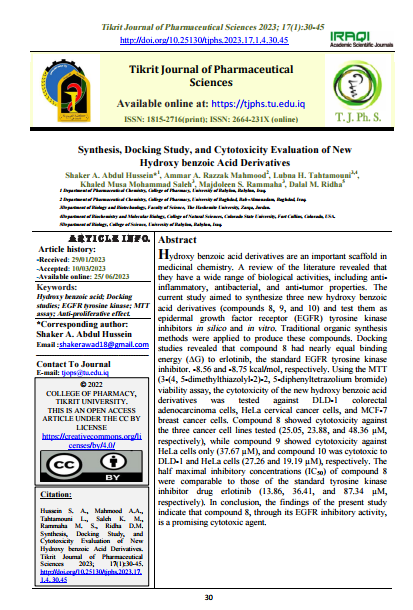Synthesis, Docking Study, and Cytotoxicity Evaluation of New Hydroxy benzoic Acid Derivatives
DOI:
https://doi.org/10.25130/tjphs.2023.17.1.4.30.45%20Abstract
Hydroxy benzoic acid derivatives are an important scaffold in medicinal chemistry. A review of the literature revealed that they have a wide range of biological activities, including anti-inflammatory, antibacterial, and anti-tumor properties. The current study aimed to synthesize three new hydroxy benzoic acid derivatives (compounds 8, 9, and 10) and test them as epidermal growth factor receptor (EGFR) tyrosine kinase inhibitors in silico and in vitro. Traditional organic synthesis methods were applied to produce these compounds. Docking studies revealed that compound 8 had nearly equal binding energy (DG) to erlotinib, the standard EGFR tyrosine kinase inhibitor. -8.56 and -8.75 kcal/mol, respectively. Using the MTT (3-(4, 5-dimethylthiazolyl-2)-2, 5-diphenyltetrazolium bromide) viability assay, the cytotoxicity of the new hydroxy benzoic acid derivatives was tested against DLD-1 colorectal adenocarcinoma cells, HeLa cervical cancer cells, and MCF-7 breast cancer cells. Compound 8 showed cytotoxicity against the three cancer cell lines tested (25.05, 23.88, and 48.36 µM, respectively), while compound 9 showed cytotoxicity against HeLa cells only (37.67 µM), and compound 10 was cytotoxic to DLD-1 and HeLa cells (27.26 and 19.19 µM, respectively. The half maximal inhibitory concentrations (IC50) of compound 8 were comparable to those of the standard tyrosine kinase inhibitor drug erlotinib (13.86, 36.41, and 87.34 µM, respectively). In conclusion, the findings of the present study indicate that compound 8, through its EGFR inhibitory activity, is a promising cytotoxic agent.

Downloads
Published
How to Cite
Issue
Section
License
Copyright (c) 2023 Tikrit Journal of Pharmaceutical Sciences

This work is licensed under a Creative Commons Attribution 4.0 International License.
This is an open-access journal, and all journal content is available for readers free of charge immediately upon publication.





